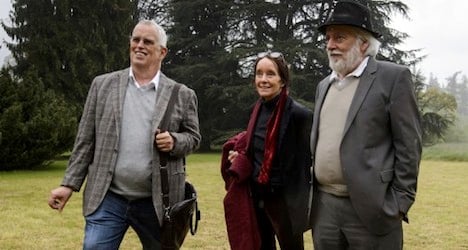To show that the project was finally on track, the promoters on Wednesday showed off the idyllic site in the village of Corsier-sur-Vevey in the canton of Vaud.
The large, white manor overlooking Lake Geneva, which Chaplin called home for the final 25 years of his life, and its surrounding park will over the next two years undergo a transformation expected to cost more than 40 million francs ($45.7 million).
As proof that the project was truly underway, a large yellow belted digger rolled across the sprawling property to a spot in sight of the house, named Manoir de Ban, and began scooping up the lawn and the rich, dark soil beneath.
The new museum will aim to have cultural and artistic aspirations, curator Yves Durand told AFP.
"We will build something unique: a museum that mixes both culture and entertainment," he said.
It took seven years to get a building permit, and before that the project organizers had to wait five years to settle a lawsuit brought by a neighbour worried about the implications of the museum.
"Now, everything is set," Durand said.
"We have the financing, the project leader, the architect, the scenographer and the green light from the family," he said with a grin.
On Wednesday, three of the eight children Charlie Chaplin had with his wife Oona were present to help sound the starting shot for the project.
'The house of his dreams'
Michael Chaplin, who after his father's death on Christmas day 1977, lived in the manor until 2008, recalled the stories of his father's unhappy childhood.
Born Charles Spencer Chaplin, the silent film legend was born in London in 1889 to poor parents who struggled to make a living as music hall entertainers.
"He lived in total misery, abandoned by his father and with a mother who was often institutionalized for psychological problems," said Michael Chaplin, 68, sporting a silvery beard and wearing a black hat.
"This manor was for him the house of his dreams, as he showed in his film Modern Times," he said, gesturing towards the building.
His father, he said, had been truly happy at the end of his life, "serving up vegetables from his garden, asparagus, peas, lettuce, not to mention strawberries."
Both Charlie and Oona Chaplin rest in the nearby Corsier-sur-Vevey cemetery, next to their good family friend and long-time neighbour James Mason, the movie actor, who died in 1984.
Michael's brother Eugene Chaplin, 61, meanwhile, told AFP that his father had "loved to walk on the lake shore, and also here in the park, every day, even if it was raining."
"My mother and my father found happiness here in Switzerland," he said.
"My father was not bothered."
The project unveiled Wednesday comprises two main components: the restoration of Manoir de Ban, a neo-classic structure built nearly 200 years ago, and the construction of a new building meant to house the museum.
The manor, which has remained empty since 2008 and is today in a sad state, and the museum building will together provide more than 4,000 square metres of exhibition space to showcase Chaplin's work.
Visitors will get a glimpse of the artist's humble beginnings in London and his spectacular rise to become one of the biggest legends in Hollywood history.
Film sets will be reconstituted, including Easy Street, which figured in several of his movies.
And the Grevin Museum, a Paris wax museum that is partnering on the project, will present some 30 wax figures representing Chaplin and the many celebrities he rubbed shoulders with.
Chaplin settled in Switzerland in the 1950s after he was barred from the United States due to suspicions in Washington, in the grip of McCarthy era paranoia about Soviet infiltration, that he had communist sympathies.



 Please whitelist us to continue reading.
Please whitelist us to continue reading.
Member comments